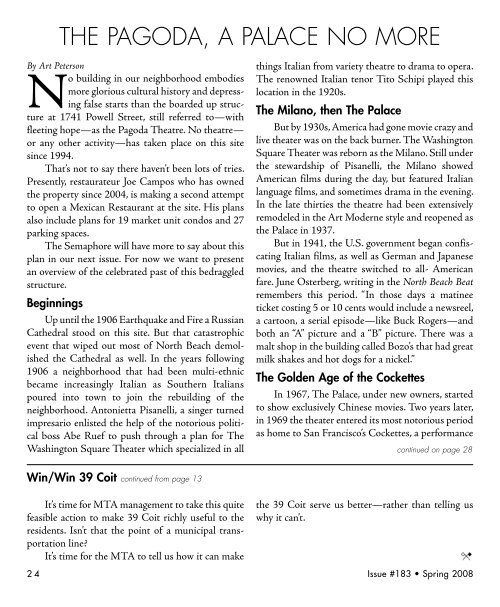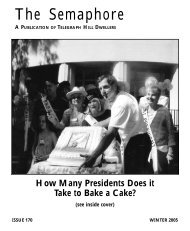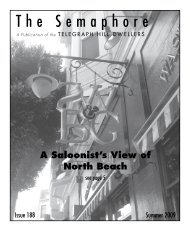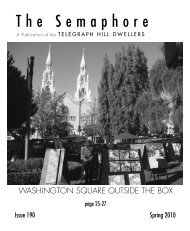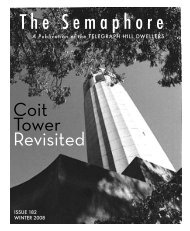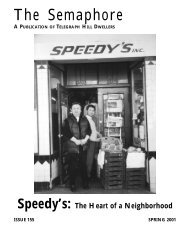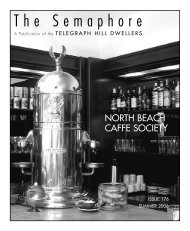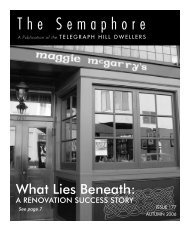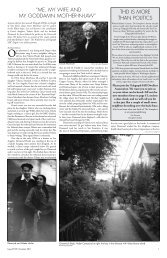Issue 183, Spring 2008 - Telegraph Hill Dwellers
Issue 183, Spring 2008 - Telegraph Hill Dwellers
Issue 183, Spring 2008 - Telegraph Hill Dwellers
- No tags were found...
You also want an ePaper? Increase the reach of your titles
YUMPU automatically turns print PDFs into web optimized ePapers that Google loves.
The Pagoda, a Palace No MoreBy Art PetersonNo building in our neighborhood embodiesmore glorious cultural history and depressingfalse starts than the boarded up structureat 1741 Powell Street, still referred to—withfleeting hope—as the Pagoda Theatre. No theatre—or any other activity—has taken place on this sitesince 1994.That’s not to say there haven’t been lots of tries.Presently, restaurateur Joe Campos who has ownedthe property since 2004, is making a second attemptto open a Mexican Restaurant at the site. His plansalso include plans for 19 market unit condos and 27parking spaces.The Semaphore will have more to say about thisplan in our next issue. For now we want to presentan overview of the celebrated past of this bedraggledstructure.BeginningsUp until the 1906 Earthquake and Fire a RussianCathedral stood on this site. But that catastrophicevent that wiped out most of North Beach demolishedthe Cathedral as well. In the years following1906 a neighborhood that had been multi-ethnicbecame increasingly Italian as Southern Italianspoured into town to join the rebuilding of theneighborhood. Antonietta Pisanelli, a singer turnedimpresario enlisted the help of the notorious politicalboss Abe Ruef to push through a plan for TheWashington Square Theater which specialized in allthings Italian from variety theatre to drama to opera.The renowned Italian tenor Tito Schipi played thislocation in the 1920s.The Milano, then The PalaceBut by 1930s, America had gone movie crazy andlive theater was on the back burner. The WashingtonSquare Theater was reborn as the Milano. Still underthe stewardship of Pisanelli, the Milano showedAmerican films during the day, but featured Italianlanguage films, and sometimes drama in the evening.In the late thirties the theatre had been extensivelyremodeled in the Art Moderne style and reopened asthe Palace in 1937.But in 1941, the U.S. government began confiscatingItalian films, as well as German and Japanesemovies, and the theatre switched to all- Americanfare. June Osterberg, writing in the North Beach Beatremembers this period. “In those days a matineeticket costing 5 or 10 cents would include a newsreel,a cartoon, a serial episode—like Buck Rogers—andboth an “A” picture and a “B” picture. There was amalt shop in the building called Bozo’s that had greatmilk shakes and hot dogs for a nickel.”The Golden Age of the CockettesIn 1967, The Palace, under new owners, startedto show exclusively Chinese movies. Two years later,in 1969 the theater entered its most notorious periodas home to San Francisco’s Cockettes, a performancecontinued on page 28Win/Win 39 Coit continued from page 13It’s time for MTA management to take this quitefeasible action to make 39 Coit richly useful to theresidents. Isn’t that the point of a municipal transportationline?It’s time for the MTA to tell us how it can makethe 39 Coit serve us better—rather than telling uswhy it can’t.24 <strong>Issue</strong> #<strong>183</strong> • <strong>Spring</strong> <strong>2008</strong>


